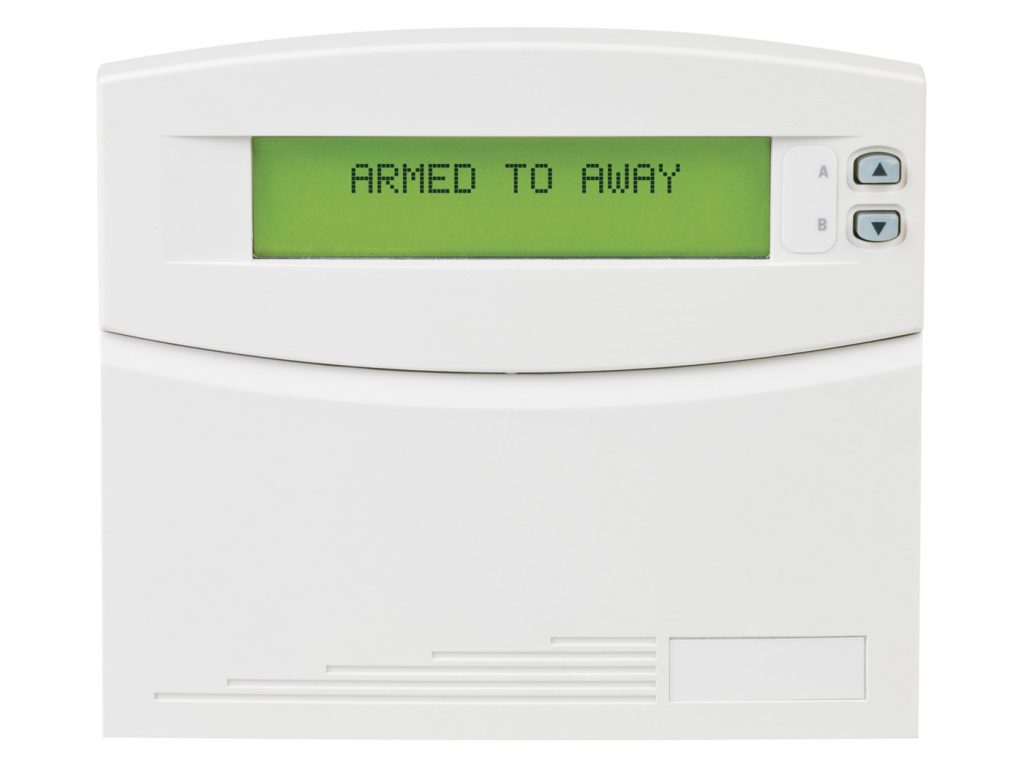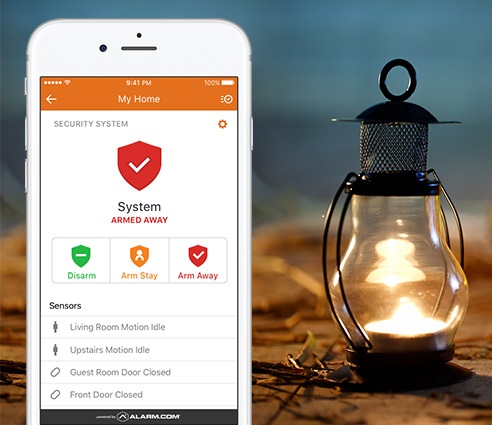As we pointed out in our post Tackling Ten Common Home Security Myths, many people get overwhelmed when tasked with using a security system. Of course, any new technology can feel intimidating. Additionally, security systems carry their own reputation for being difficult. When many people think about security systems, they think of beeps, numbered buttons, and codes. Along with that confusion comes the fear of what security systems do, and when. How do alarm users avoid false alarms? Can motion sensors stay “asleep” while people are at home? What happens if someone arms the system while a window is open? Customers often worry about the answers to these types of questions. However, they generally feel pleasantly surprised after using their new security system after we customize it to work exactly how they want it to. In this post, we share a variety of security system arming options to better explain how our security systems operate.
We will begin by discussing the two most basic arming options. Most security systems have some version of “Stay” and “Away” arming modes. After that, we will discuss customizing arming options for individual sensors. Then, we will focus on how alarm users arm their security systems even while leaving a door or window open. This ability to “bypass” sensors lets homeowners keep their alarm systems armed as frequently as possible. Finally, we will also look at some unique ways that our customers arm their security systems without even using a keypad. Now, let’s begin with a look at our two most popular arming options!
Should I Stay or Should I Go?
Several months ago, we created a post providing 5 Security System Use Tips. In that post, we gave the advice of arming your security system even while home. Many potential alarm customers assume that they do not have this option! However, most alarm systems allow users to either entirely or partially arm their systems. By assigning different sensors as “perimeter” sensors, we can allow customers to arm certain parts of their alarm system and still walk around the house. On the other hand, customers leaving their homes generally wish to arm their entire system. These two options are often called “Stay” and “Away,” based on whether customers are staying home or leaving the premises. Let’s look at how we create these two options now!

Arming an alarm system, such as this model by Interlogix, to “Away” mode generally activates all perimeter sensors as well as motion detectors.
“Stay” Mode
Arming your security system to “Stay” mode (occasionally also called “doors and windows” mode) allows you to walk around your home without causing a false alarm. Security systems can consist of many different types of contacts. Sensors on doors and windows can detect breaches at these important points of entry. Additionally, motion detectors can detect motion within the house. Glass break detectors can recognize the sound of breaking glass and activate the alarm upon detection.
Generally speaking, selecting “stay” mode while arming your security system arms only your door and window sensors, as well as glass break detectors. This keeps motion detectors from picking up movement within the house and activating an alarm. However, you can create exceptions to this rule. For example, perhaps you wish arm a basement motion detector in “stay” mode. We can program the detector as a “perimeter” sensor for you and make that happen. Conversely, maybe you have an interior basement or garage door with a sensor on it. You may wish to only activate that sensor while arming your system to “Away” mode. By doing this, you allow residents to use this door without activating the alarm while the system is armed to “Stay.” Now, let’s take a closer look at what happens when you select “Away” mode to arm your security system.
“Away” Mode
As the name suggests, users arm their security system to “Away” mode when leaving the house. Occasionally, alarm manufacturers label this option something more wordy, such as “Doors, Windows, and Motions.” Either way, this option arms both perimeter sensors and interior sensors. Additionally, this mode arms any door or window sensors that you have set up to only arm in “Away” mode. This often includes interior doors, as we discussed in the previous section. At this point, we have looked at the two most popular security system arming options. However, you still have a couple options that can change the way your security system works based on your own individual security needs. Now, let’s look at some of these lesser-known options!

“Always on” sensors allow you to continuously arm certain parts of your home even when your security system is disarmed.
“Always On” Sensors
As their name implies, “always on” sensors will always activate an alarm response. For example, monitored smoke and carbon monoxide detectors will create this response whether or not you have your alarm system armed. Furthermore, environmental sensors such as freeze sensors and flood sensors will also create an alarm response at all times. The same goes for police and medical panic buttons, which users can activate at any time to sound their alarm siren and create the desired central station response.
Finally, homeowners can even grant traditional door/window sensors and motion detectors “always on” status. Perhaps you have a far-off door in a basement that you never use. This would make a good location for a sensor that always creates an alarm response. Allowing homeowners to add this security can make them feel much more at ease knowing that the more remote areas of their home are secure even while the rest of the alarm is disarmed. This option allows you to arm a very small portion of your alarm system at all times. Now, let’s look at how customers can bypass sensors to secure large portions of their home while leaving small sections disarmed!
Bypassing Sensors
The ability to bypass sensors allows homeowners to arm their security system with the exception of a few sensors. When told about this option, some customers puzzle as to why someone would want to arm most of their alarm system. However, scenarios do arrive that makes this arming option valuable. For example, customers with window sensors may want to arm their alarms at night while opening their bedroom windows to let air in.
Similarly, some customers bypass their exterior garage door sensor when working in their yard. This allows them to go in and out of their garage while working, all while keeping the home armed. At this point, we have looked at several types of unique arming options for your home alarm system. Now, let’s look at a different category of options for arming your security system. In the next section, instead of focusing on how an alarm functions after selecting a specific arming option, we will look at some of the different ways customers can arm their security system without even using the alarm’s keypad!

The Alarm.com interactive cellular dialer allows you to arm your security system remotely.
Unique Methods for Arming Your Alarm
As we pointed out earlier, customers often find themselves intimidated by the prospect of installing an alarm. Making the alarm system easier to use often puts these homeowners’ mind at ease. After all, new customers like to feel as comfortable as possible while learning the new technology. Additionally, they want to feel that guests who might need to use the alarm system feel comfortable as well. Our key fob remotes can provide this ease of use for those nervous about operating an alarm system. Simply pressing the “unlock” button disarms the system without the need to enter a code or approach the keypad. Additionally, pressing the “lock” button will arm the system to “Stay” mode, and pressing it a second time will place the alarm in “Away” mode. This simplicity makes key fobs a very popular piece of equipment for our customers.
We also offer interactive cellular monitoring services that allow customers to arm and disarm their security system with their smartphones! We install cellular dialers as a means of allowing alarms to communicate to the central station. This allows households without phone lines or with phone lines that go down to stay monitored consistently. Furthermore, our cellular dialer, powered by Alarm.com, allows users to control their alarm system through a smartphone or any internet-enabled device. This ability is what makes “interactive” cellular monitoring stand out from other cellular monitoring services. With this service activated, Alarm.com users can arm — and disarm — their alarm system remotely from anywhere in the world. This is one of our most unique and popular security system arming options!
Creating the Security System Arming Options that Work for You
We hope that this post has given you some valuable information about some of the many security system arming options. Maybe you’ve thought about getting an alarm system, but need more information on the “nuts and bolts” of how families use them every day. Or perhaps you even have an alarm system that you have yet to use to its full potential. Either way, we encourage you to contact us with any questions you may have. We will happily answer any security-related queries. Additionally, we offer free home site surveys for both new and existing alarm customers. While on site, we can help design a security system that does what you need, when you need it. Together, we can create a home security plan that keeps you, your valuables, and your family as safe and secure as possible.
